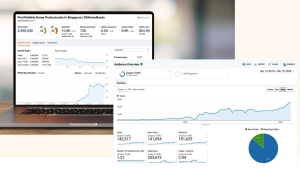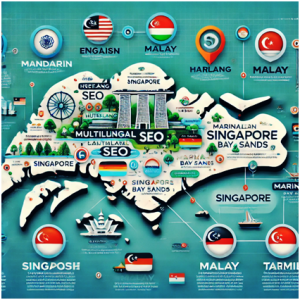The online landscape is highly competitive, so mastering and applying effective SEO in Singapore is no longer optional—it is a necessity.
Only 0.63% of visitors go beyond the first page on Google search results. Moreover, the first listing has a considerable CTR of 27.6%, highlighting the need to aim for the consistent top ranking. (Source: Backlinko User Behaviour Study)
This guide will best serve businesses and marketers interested in getting a higher rank, capturing organic traffic, and precisely addressing local communities’ needs. Given that Singaporeans’ use of search engines continues to grow with mobile and localised searches, we offer comprehensive guidance on the key to visibility in this competitive market.
This guide addresses keyword research, technical SEO, multilingual content, and local search optimisation. It will assist you in navigating the current SEO in Singapore. Whether starting or looking to improve your existing strategies, let’s explore how to increase your online presence while keeping it genuine to Singapore’s digital audiences.
Understanding the SEO Landscape in Singapore
In Singapore’s intense digital economy, ranking on the first page of the search engine results is crucial.
Effective SEO (optimisation) is critical for maintaining a competitive advantage in Singapore’s ever-changing industry. SEO methods are intended to increase targeted website traffic, boost search engine ranks, and generate high-quality leads, which are critical in satisfying consumer expectations and ensuring corporate success.
Singapore’s Unique Digital Environment
A 2023 Digital Report on Singapore revealed that the mega platform captures 95.1% of the search engine share. According to Staista, Google is also the leading platform among consumers in Singapore, with around 96% of the population using the internet. Furthermore, the rising mobile internet share (now 66.8%) emphasises the significance of optimising mobile devices. (Source: 2022 Singapore Digital Marketing Insights by AsiaPac)
Despite this tendency, desktop usage has grown significantly, emphasising the importance of a strategy that efficiently caters to many device types for smooth user access.
Local Search Intent and Behavior
In Singapore, local search intent frequently concentrates on hyper-specific inquiries such as “near me” queries or phrases related to MRT stations. Singaporeans rely significantly on mobile devices; therefore, mobile-first optimisation is essential for ranking high in local searches. Businesses must also link their strategy with seasonal demand surges, such as the Great Singapore Sale or festival seasons for high-intent local traffic.
Cultural Relevance and Multilingual SEO
Singapore’s cosmopolitan setting demands material that appeals to its varied populace. Implementing multilingual SEO tactics, such as optimising for English, Malay, Mandarin, and Tamil, allows organisations to interact with various audiences. Localised material that combines local subtleties, holidays, and customs promotes authenticity, trust, and relevance to Singaporean viewers.
With these essentials established, a well-organised SEO strategy that reflects local search habits and cultural subtleties will enhance your brand’s presence in Singapore’s digital environment.
Mastering Keyword Research for Strategic SEO Success
Keyword research is crucial for any SEO campaign, especially when the market is as dynamic and diverse as Singapore. It needs to be practically localised, intent-driven, and very detailed. Knowing how particular search patterns, cultural differences, and local trends work enables you to create content that ranks highly and appeals to Singapore’s inhabitants.
Here is how you can incorporate keyword research as a primary objective for your content strategy to bring sustainable SEO results.
Localize Keywords for Singapore-Specific Intent
To connect with the local audience, an excellent place to start is with Singaporean keywords such as ‘in Singapore’ and ‘SG’, suburb names like ‘Orchard Road’ or ‘Jurong East’, and similar terms.
Google Keyword Planner, Ahrefs, and SEMRush greatly help in this regard, revealing search volume and competition, among other things. Also worth noting is that many different tools, such as Google Trends, can help uncover local events in Singapore that are likely to dramatically increase demand for particular goods (for instance, the Great Singapore Sale or National Day celebration).
Adjusting the generalities of these terms to suit the nation of Singapore is a perfect way of increasing the relevance of such search terms, thereby increasing the chances of good visibility for your content.
Using Long-Tail Keywords for Intent Matching
Long-tail keywords, usually three or more words, are crucial for attracting audiences with specific, explicit intent.
While “SEO services” is a broad term, phrases like “affordable SEO services for SMEs in Singapore” are more likely to draw in visitors ready to convert. With the increasing popularity of voice search, it’s also beneficial to think about conversational phrases that reflect natural speech, such as “best SEO agency for startups in SG” or “where to find local SEO experts in Singapore.” Long-tail keywords often face less competition, bringing in niche, high-value traffic.
Identify Content Gaps through Competitor Analysis
The evaluation of competitive keyword strategies may indicate areas for potential benefit. For example, the Content Gap feature of Ahrefs can help find keywords that the competitors are ranking for but are only partially covered so one can develop a more engaging piece of content.
Furthermore, Google ‘People Also Ask’ and related searches can help find questions audiences may have that competitors may have missed. Utilise this to build valuable and relevant Singapore content that fills these voids, addresses other questions, and provides more practical information.
Develop Content Clusters and Optimise for User Intent
Structuring your content into topical clusters enhances SEO and improves user experience.
Begin with a central pillar page, like “Guide to SEO in Singapore,” and link to supporting pages that delve into narrower subjects, such as “Local SEO Tips,” “Keyword Research for SMEs,” and “Content Marketing in Singapore.”
Each piece should cater to specific user intents—seeking information, navigation, or transactions—assisting users at different stages of their journey while establishing your authority in the field.
Optimising On-Page SEO for Local Relevance in Singapore
On-page SEO helps search engines appreciate the worth of every page on a website and the needed information readily available to users. As the digital space is very dense in Singapore, working on the local relevance of the website’s on-page components can boost your position considerably.

Here is the simple, on-page SEO technique that works in 2024.
Optimising Title Tags, Meta Descriptions, and Headers
Are you interested in catching users’ attention instantly? Then, optimise content to help the search engine understand its relevance. When catering to the people of Singapore, pay attention to the following: Naturally using the relevant keyword: Incorporate keywords early in the titles or headers, such as in ‘SEO Strategies for Singapore Businesses (2024)’.
Use keywords specific to the region, i.e., place names. For instance, use the word Singapore or its abbreviation SG or the names of particular areas, such as Orchard Road or Changi Airport, to appeal to the locals and get more results in Singapore searches.
Ensure the title tag length is 50 to 60 characters and the meta description is less than 155 to avoid a cut-off. A well-designed title or meta description will likely increase the click-through rate (CTR), which helps the ranking since it implies value in the content the user posts.
Write Engaging, High-Quality Content for Target Audience
Content tailored to the preferences of Singaporean users is crucial. Considering Singapore’s mobile-first habits, your content should be concise, informative, and visually engaging:
- Local relevance: Use Singapore-specific examples, regional case studies, or market trends. Content that includes local insights resonates more and encourages greater engagement.
- Scannable structure: Utilise short paragraphs, bullet points, and multimedia elements like videos or infographics to make content easily digestible on mobile devices.
- Catering to multilingual users: Singapore’s multiethnic makeup embraces content in English, Mandarin, and, in some cases, Singlish, expanding its reach.
Content Quality improves time spent and reduces bounce rates, which are good signs for search engines.
Optimal Internal Linking to Enhance Site Architecture
Strategic internal linking not only aids search engines in understanding your site’s organisation but also directs users to relevant pages, increasing engagement:
- Use clear anchor text: Avoid using “click here.” Instead, opt for specifics like “discover more about SEO for Singapore SMEs.”
- Organise content into clusters: Develop a central “pillar” page on broad subjects like “SEO in Singapore,” linking to related topics such as “Local Keyword Research” or “SEO Trends 2024.” This approach enhances site authority and simplifies navigation.
- Link to high-traffic pages: Direct users to popular pages, encouraging them to spend more time on your site.
A well-planned linking strategy enhances SEO relevance and improves user experience, leading to better overall site engagement.
Implement E-E-A-T Principles to Establish Local Credibility
Content that aligns with Google’s E-E-A-T (Experience, Expertise, Authority, Trustworthiness) criteria indicates reliability to both users and search engines:
- Highlight local expertise: Incorporate quotes or insights from Singaporean experts to strengthen relevance.
- Include local statistics: Citing Singapore-specific data or case studies enhances authenticity and relatability.
- Feature testimonials from local clients: Social proof from Singaporean businesses boosts credibility.
Emphasis on E-E-A-T enhances your content’s credibility, encouraging local audiences to partake more.
Optimising Technical SEO for Singapore in 2024
Effective technical SEO practices ensure that a website performs exceptionally well with search engines, that the user experience is free of hitches, and that ranking improves.
Let’s explore some of the best technical SEO approaches in Singapore.
1. Mobile Optimisation and Responsive Design
Mobile optimisation is crucial considering Singapore’s high number of mobile internet users. Web designers must diligently consider that Google is now ranking pages based on mobile versions of a site first with friendly mobile indexing.
- Responsive Design: Tweak designs depending on the screen size of a device to offer a cohesive experience in different devices.
- Mobile Navigation System: Add buttons, but do not add annoying pop-ups that may lead to abuse.
To test how mobile-friendly your website is, you can use various tests, including Google’s Mobile-Friendly Test, as one of the testing tools.
2. Optimise Site Speed and Accessibility
Improving how fast a website loads is another crucial aspect of increasing user participation and improving search engine rankings. Among Google’s Core Web Vitals, there are three metrics that every website owner should pay attention to since they affect the overall experience of users:
- Largest Contentful Paint (LCP): Aim for 2.5 seconds on your site to be considered loading in a reasonable time.
- First Input Delay (FID): This should be less than 100ms to assure users of the attendance of their actions.
- Cumulative Layout Shift (CLS): Ensure this remains below 0.1 to prevent the content layout from shifting unexpectedly.
Employ solutions like Google PageSpeed Insights to help visualise which areas need improvement, e.g. reducing code and using lazy loading for pictures and videos.
3. Image Optimisation for Load Time
Images add attractiveness but can slow the page, especially on mobile devices. There is no doubt that image file optimisation helps achieve loading speed and ease of access:
- Descriptive File Names—To improve SEO, Use proper keyword-enriched descriptive file names (e.g., “Marina-Bay-Sands-Singapore.jpg” rather than “image1.jpg”).
- File Compression—Input distorted images; the quality will be the same after resizing images with Tinypng image optimisation tools.
- Alt Text—Write precise, informative alt text for all images, making it easier to search and identify the photos for people who cannot see them. For instance, “Aerial view of Marina Bay Sands in Singapore.”
Doing these adjustments helps improve the SEO of the website as a whole.
4. Ensure Fast Page Load Times
Given Singapore’s mobile-focused user base, quick loading times are crucial:
- Use caching: Caching saves site elements for faster load times on repeat visits.
- Minimise code: Streamlining CSS, HTML, and JavaScript enhances load speed.
- Use a CDN: A Content Delivery Network allows content to be accessed from the closest available server, thereby reducing latency, especially for users in the same region.
You can also use Google’s PageSpeed Insights to analyse and recommend actionable speed improvement elements that impact user experience and rankings.
5. Site Structure and URL Enhancement
Proper site structure increases user-friendliness and assists search engines in crawling and indexing pages more effectively.
- Ordering structure: Distribute content coherently, associating major themes with minor ones and ensuring pages fit within 3-4 clicks from the main page.
- URL Structure: Make the URLs brief, informative and keyword-rich, such as “/seo-services-in-singapore” for higher likeliness.
Manage internal links periodically to ensure all pages are accessible and valuable.
6. Secure HTTPS for User Trust and SEO
Security is crucial for ranking, as users and search engines prefer HTTPS sites over HTTP.
- SSL Certification: The entire site should come under the secured cover of HTTPS to lock out potential unauthorised users and win their confidence.
- Redirect HTTP to HTTPS: Apply 301 redirection where applicable so that all HTTP versions point to HTTPS to eliminate content duplication and protect SERP standings.
Always replace the existing SSL certificates if you do not want any distractions from users and search engines.
7. Optimising XML Sitemap and Robots.txt to Reduce Crawl Budget
To facilitate and improve the visibility of crawl budgeting techniques by managing the pages that matter the most.
- XML Sitemap: Add key pages to your sitemap and submit it through Google Search Console.
- txt: To facilitate the crawling activity, limit access to certain pages that are not useful, such as duplicate pages and the admin panel.
To enhance and keep the crawl budget’s focus in check, routinely revise the XML Sitemap and Robots.txt according to changes made to the site content.
8. Handling technical issues and 404 pages
With a considerable mobile user base in Singapore spending an average of 4.51 hours per day on their phones, mobile-centric practices that enhance the user experience through search engine optimisation increase engagement and conversions. Timely intervention on technical issues is crucial at this time, as loss of traffic will mean loss of ranking because the majority of the users will not go back to the site. (Source: Statista Demographics Research)
- Management of 404 Error: Set up 301 redirects for all deleted pages to maintain a consistent user experience and avoid dead links. Create a personalised 404 page that complements your site’s appearance. Include valuable links that will direct people back to crucial pages and encourage them to stay on your website.
- Management of Server Errors: Monitor the site regularly for server faults, such as 500 errors, and fix them as soon as possible to reduce downtime and provide a consistent user experience. The quick resolution provides consumers with ongoing access while protecting search engine rankings.
Utilising tools like Google Search Console to monitor indexing problems and broken links will aid in quick detection and resolution, ultimately leading to a smoother and more optimised user experience.
9. Canonicalisation for Duplicate Content
Duplicate content can weaken your SEO strategy. Utilise canonical tags to indicate the main version of similar pages.
- Canonical Tags: Apply canonical tags on pages with duplicate or closely related content to unify SEO authority.
- Avoid Thin Content: Make sure every page offers unique and valuable information tailored for Singaporean users.
Regularly audit your website for duplicate content to uphold SEO quality.
Off-Page SEO: Building Authority and Trust in Singapore
Off-page SEO is important for enhancing your site’s credibility and trustworthiness through factors outside the site. Given Singapore’s cutthroat digital marketing environment, an excellent off-page optimisation strategy can take your site over the top and enhance its rankings. Here’s how you can improve your off-page SEO in 2024.

Link Building: Quality over Quantity
Most link-building strategies aim to obtain backlinks from authoritative and topical inbound websites. Seek to establish links that reinforce your presence in the Singapore market.
- List your business on reliable Singaporean directories such as SG Links or SGP Business. Niche directories can also help demonstrate your relevance in specific sectors.
- Contribute high-quality content to well-regarded Singaporean blogs. Contextual backlinks from these platforms can enhance your SEO and boost your credibility.
- Cultivating relationships with journalists through platforms like HARO or targeted PR efforts can lead to valuable backlinks and mentions in Singapore’s media, increasing your authority.
Leveraging Social Media Signals for Building Brand Loyalty
While social media engagement may not directly help search rankings, it does play an essential role in increasing content visibility. Increased exposure can indirectly help with SEO by attracting more people to your site and promoting backlinks.
- Tailor your material to appeal to a wide range of Singaporeans by including local cultural features and communicating directly with the audience. This technique boosts your brand’s visibility and attracts targeted traffic.
- Partnering with local influencers or prominent personalities can increase engagement. These individuals frequently have a clear target audience, and working with them boosts your chances of bringing more customers to your company.
The Role of Online Reviews
Reviews are critical for trust in certain groups, such as Singapore, as people listen to other consumers’ opinions. Positive reviews, which are challenging to find emanating from one or two customers, would dramatically help in online reputation management and local search engine optimisation.
- Include all the necessary information in the GMB profile, relevant and attractive images and participation in the reviews. It helps improve local SEO, increase positive reviews, and show how you respond to all reviews regardless of their nature.
- Maintain robust profiles on industry-specific platforms like TripAdvisor, Agoda, or Zomato, which Google frequently indexes. Positive reviews on these sites can enhance your brand’s reputation and improve SEO.
Community Engagement and Local Sponsorships
Connecting with the local community can boost brand visibility, drive traffic, and establish a network of trust signals.
- Participate in concerts or philanthropic events in Singapore to increase your brand awareness and visibility. Sponsorships often offer functional possibilities, like backlinks to event websites, mentions in news stories about the event, and social media shoutouts.
- Collaborate with firms that complement your products by co-hosting events or running joint advertising. For example, a fitness firm might collaborate with surrounding fitness centres on marketing efforts, share promotional messages, and establish reciprocal backlinks, thus increasing reach and trustworthiness.
Content Syndication on Authority Sites
Distributing content on reputable platforms can help expand your reach and naturally build backlinks.
- Target regional sites like The Straits Times or AsiaOne for content syndication. Use canonical tags to credit your website while broadening your content’s reach.
- Even though web 2.0 sites like LinkedIn or Medium carry little SEO value, posting on these helps to establish one’s authority, prompts users to share, and increases traffic.
A Step-by-Step Process for Local SEO in Singapore
In the landscape of Singapore’s marketplace, local SEO becomes essential in penetrating the local audience and improving visibility. Thus, this is a short guide on creating a practical local SEO marketing plan to help you get more customers and improve your online visibility.
Step 1: Set Up Google My Business (GMB) the Right Way
A well-optimised GMB profile is essential for a local search, especially for mobile and ‘near me’ searches.
- Fill Each Section: Ensure that the business name, address, phone number (NAP), opening hours and categories are correct and consistent throughout all platforms.
- Upload Good Quality Pictures: Clear pictures of the storefront, product, or service create a good impression.
- Use GMB Posts: Informing clients regularly about special offers or events helps keep the audience focused even when there is no engagement.
- Ask for Reviews: Reviews help make the ranking and rating credible. Please include a link to your profile to make it easy for clients to give reviews.
Step 2: Go for the Local Keyword Research
Make sure you modify the keywords to fit the requirements of the Singaporean-situated search.
- Singapore-Specific Keywords: Utilise tools like Google Keyword Planner to find keywords relevant to the area, such as “hair salon Orchard Road.”
- Include “Near Me” and Conversational Phrases: Singaporeans frequently use phrases like “near me.” Incorporating these into your content can attract local users.
- Integrate Targeted Keywords Within Content: To increase relevance, integrate local keywords in the right proportions across your homepage, service, and blog pages.
Step 3: Build Local Listings and Verify NAP Coverage
Consistent citations help to build your business’s authority and are also beneficial for search rankings.
- Register with Local Directories: Singapore-based history provides various directories, such as SG Links and SGP Business, which are quite advantageous.
- Choose Niche Directories: Exclusive directories, such as HungryGoWhere for hotels and restaurants, help to generate traffic and enhance credibility.
- Adhere to NAP Uniformity: Make sure your name, address, and phone number are the same across all platforms to ensure clarity among potential clients.
Step 4: Solicit and Supervise Customer Appraisals
Customers’ input is a cornerstone in trust building and local SEO in Singapore.
- Seek Positive Reviews: After a fresh, satisfying experience, convince the clients to write a review on GMB. Google My Business provision (GMB), including an in-store QR code, speeds up this task.
- Reply to All Reviews: Thank all the commenters who left encouraging comments and handle all the spoilers in a manner that shows you care about their opinions and feedback.
- Diverse Review Circles: Ask clients for feedback on sites like Facebook, TripAdvisor, and other Singaporean-focused sites.
Step 5: Create Content with a Local Focus
Relevant content can help draw the local audience while understanding content enhances the search ranking.
- Target Singapore Audience: Consider writing blog posts on topics relevant to the local area’s search traffic objectives, such as “Best Cafes in Tanjong Pagar.”
- Advertise Local Activities: To increase reach and involvement, include local activities in the content or other businesses in the area.
- Include Local FAQ Section: In keeping with local search principles, address issues most likely to be experienced by users from Singapore, such as working hours or whether local delivery is available.
Step 6: Undertake Mobile and Voice Search Optimization
Since mobile devices contribute to 58.67% of search traffic, mobile SEO is vital. It is particularly true for local searches, considering that 57% of local searches occur on mobile, suggesting the need for local mobile optimisation. (Sources: Statista and 2022 Local SEO Report by ReviewTrackers)
With a year-on-year growth rate of 14.24%, Statista also projected that the speech recognition industry in Singapore is expected to reach a market size of US$77.57 million by 2030. The data shows a growing adoption of voice technology, which must open up more avenues for optimising SEO persistence in voice search.
Step 7: Follow Up and Fine-tune Strategies Using Local SEO Tools
Consistent evaluation and adjustment of a strategy is an inescapable milestone to maintain the effectiveness of local SEO.
- Google Analytics and Search Console provide details of the local traffic sources, pages that are performing well, and areas that need improvement.
- Reviewing management activities requires the use of specialised tools. BrightLocal or Yext, for example, help business owners monitor reviews across different channels to manage their reputation quickly.
- Evaluate ranking functionalities with local SEO Tools like Ahrefs, Moz Local, and SEMRush. These tools help track the rankings of geo-targeted keywords to ensure all local searches point to your brand.
Case Study: Homees – Driving Organic Traffic Growth
Homee is a Singapore-based home service platform. They wanted to improve their local exposure, attract a wider audience, and create meaningful connections through SEO. The aim was to compete in a local search, mobile-first landscape while meeting homeowners’ diverse informational demands.
Challenges
- Competing for ranks in Singapore’s highly localised search market
- Addressing user behaviour dominated by intent-driven and mobile-first queries
- Meeting the different informational demands of homeowners seeking reputable service providers
SEO Strategy
Localised Keyword Targeting
- Conducted extensive research to uncover high-value keywords such as “electricians near me” and “plumbers in Singapore.”
- Keywords were included in optimised text and on-page features to attract consumers with instant service requirements.
Content Optimisation
- Created extensive instructions, checklists, and FAQs to answer typical homeowner problems.
- Branded Homees as a trustworthy resource in the home services market, resulting in increased interaction.
Technical SEO enhancements
- Improved mobile usability with quicker loading times, responsive design and easy navigation.
- Improved website structure to ensure smooth user flow and effective indexing and crawling by search engines.
Off-page SEO and link-building
- Secured authoritative backlinks from local directories, industry websites, and relationships with established Singaporean platforms.
- Increased brand reputation and exposure in local search results.
Results
- The site currently receives more than 40,000 organic visitors a month.
- The estimated monthly traffic value is SGD 25,000, indicating an engaged and targeted audience.
- Homee achieved top ranks for various home service-related queries, cementing its reputation as a trustworthy brand.
Key Takeaways
This example demonstrates the transforming potential of an effective, local SEO campaign. Brands may dramatically improve their engagement and visibility in local markets by aligning with user intent, using Singapore-specific keywords, and improving technical performance. Homees’ success highlights the necessity of knowing market peculiarities and using a personalised strategy to achieve long-term growth.

Multilingual SEO in Singapore: Key Actions for Success
Multilingual SEO is critical in Singapore’s diverse and multilingual society. Businesses that adjust their content to essential languages such as English, Malay, Mandarin, and Tamil may reach a larger audience, improve user experience, and build better connections with varied user groups.
Why Does Multilingual SEO Matter in Singapore?
- Broad Reach: Localising information in several languages allows firms to appeal to local and worldwide audiences.
- Better User Experience: Native-language information is more successful at establishing trust and engagement.
- Cultural Relevance: Optimised material consistent with Singapore’s unique cultural and linguistic nuances promotes authenticity.

Best Practices for Effective Multilingual SEO
1. Optimise On-Page Elements
- Customise meta descriptions, titles, and headers using language-specific keywords.
- Avoid automatic translations; use a skilled translator to capture cultural subtleties and avoid inaccuracies.
2. Leverage Hreflang Tags
- Add hreflang tags to all pages to indicate language variations to search engines (for example, hreflang=”en-sg” for English in Singapore).
- Create URLs with subdomains or subdirectories (e.g., mysite.com/zh-sg/ for Mandarin, mysite.com/en-sg/ for English).
3. Create culturally relevant content.
- Create articles and images highlighting local interests, recognisable locations, and culturally relevant components.
- Customise calls-to-action (CTAs) to meet the needs of each language group.
4. Target Local Keywords and Voice Search
- To uncover popular search keywords in various languages, use tools like Baidu’s Keyword Tool or Google Keyword Planner for local insights.
- Include conversational terms corresponding to people’s speech, such as “best cafes near Orchard Road” in Mandarin or English.
- Concentrate on realistic, conversational questions typically used in local dialects or ordinary speech patterns.
- Include structured data and ensure that snippets are optimised for voice-assistant devices to increase your website’s exposure to voice search results.
Drawing on Content Marketing for SEO Impact in Singapore
Content marketing is critical to SEO since it increases organic traffic, builds authority, and engages Singapore’s varied audience. Organic search is affordable, with 49% of content marketers believing it is a worthy long-term investment. (Source: #SEJSurveySays poll by Search Engine Journal)
Businesses that provide high-quality, regionally relevant content may attract search traffic at all phases of the purchasing process, from awareness to decision-making. The following are crucial tactics for successfully merging content marketing with SEO in Singapore.
Prioritise High-Quality Local Content
Focus on themes relevant to Singaporeans, like local events, trends, and cultural traditions. For example, blogging about the “Best Hawker Centres in Singapore 2024” or seasonal tips for Chinese New Year might increase interaction. Businesses can target geo-specific keywords such as “near Orchard Road” or “in Singapore” to improve search visibility.
Create Evergreen Content
Create timeless articles that offer consistent value, like “The Ultimate Guide to HDB Renovations.” Regularly refresh information by updating data or providing new insights. Combine similar pieces into a content hub, such as a “Living in Singapore” guide, to increase SEO rankings and user engagement.
Address All Buyer Stages
Create material that caters to the demands of different audiences.
- Awareness Stage: New users are drawn to informative blogs like “Top Cultural Experiences in Singapore”.
- Consideration Stage: Guides such as “Choosing Sustainable Furniture for HDBs” assist decision-making.
- Decision Stage: Testimonials and case studies establish confidence by demonstrating successful outcomes for Singaporean clients.
Leverage Visual and Multimedia Content
With 85% of Singaporeans (5.13 million individuals) regularly using social media for an average of 2 hours and 14 minutes daily, visuals such as infographics and videos are essential for catching attention. (Source: Digital 2024 Singapore Report by We Are Social)
Short Instagram posts or TikTok videos on subjects such as “Hidden Food Gems in Singapore” might help increase visibility. To improve SEO, optimise multimedia using descriptive file names, alt text, and relevant keywords.
Maximise Multi-Channel Promotion
Promote your material on email newsletters, social media, and local channels to increase reach. Partnering with local influencers may raise awareness, particularly among specialist audiences. Ensure your content is responsive, with adaptable design and straightforward CTAs such as “Call Now” or “Find Directions.”
Measuring, Analysing, and Readjusting Your SEO Strategy
There comes a point in designing an SEO strategy when it is only that; however, to develop and sustain a presence in Singapore’s digital space, one needs to assess the situation and seek to make changes period after period. Here is a simple guide on how data helps you improve your SEO.

Set Clear and Objective Goals
SEO initiatives should ideally have tangible outcome levels to direct your actions and develop ways of gauging success. For example:
- Traffic & Visibility: The share of organic traffic will increase by XX % (or XX% increase within 3 months).
- Conversions in e-commerce: If a page quickly gets high-quality traffic and converts well, set a particular conversion enhancement target for that page.
Defining targets helps you focus only on the essential measurements and enables you to appreciate when there is progress.
Evaluate Performance on Various SEO Aspects
Some metrics will only be possible to evaluate the success or failure of your SEO strategy. Some of the most essential SEO indices to measure are:
- Organic traffic: Check how many people visited your site because of an organic search and which pages were the most effective for this traffic.
- Keyword Rankings: Use third-party tools like Ahref or Google Search Console. You should often check the rankings for target keywords, including those with the highest priorities.
- Click-Through Rate (CTR): Find your CTR to determine whether your meta titles and descriptions are engaging enough for people to click on them. With the audience targeting, expect a high CTR. If this is not the case, the audience requires more stimulating snippets.
- Bounce Rate and Dwell Time: A high bounce rate is a warning sign related to relevance or user experience problems, and a low dwell time illustrates the poor quality of web content.
- Conversion Rate: Measure and analyse only conversions that occur from organic traffic. Search and use Google Analytics ‘Goals’ option to track what search visitors do on the site and whether they take any actions.
- Backlink Growth: Quality backlinks boost your site’s authority. Track new backlinks and evaluate their quality using tools like Ahrefs or Moz.
Analyse SEO Data for Insights
Once you have tracked the metrics, interpreting the data becomes essential. Here are some methods to extract actionable insights:
- Traffic Analysis by Channel: Assess organic traffic compared to other channels to understand SEO’s role in overall growth.
- Keyword Performance: Pinpoint the top-performing and lagging keywords, adjusting your targeting based on search intent.
- Content Effectiveness: Evaluate the pages where users spend the most time or share frequently. This information can guide your future content strategies.
- User Journey: Trace the path from conversion entry, identifying pages with high drop-off rates to enhance user flow.
Make Data-Driven Modifications
Continuously improve your SEO strategy or expand it using new measures depending on the results you get to increase performance over time. Think about these corrections:
- Optimise Underperforming Pages: Reassess the content, structure, and keyword usage on pages with lower rankings or conversions. Try new headlines or multimedia elements to improve relevance.
- Refine Keyword Strategy: Utilise data to discover new long-tail or local keywords that resonate with Singaporean search behaviours.
- Enrichment of User Experience (UX): Whenever you notice increasing bounce rates or decreasing dwell times, improve UX elements like load speeds, ease of navigation, and mobile friendliness.
- Use Top Performing Content: Repurpose some of your best content into blogs, videos, and infographics for an expanded reach and more traffic.
- Expand Link-Building Efforts: Investigate which content garners the most backlinks and concentrate on similar topics. Emphasise local link-building with Singapore-based sites to enhance authority in the local market.
- A/B Test Key Elements: Test different headlines or CTAs to determine what resonates best. For example, compare “Download Our Singapore Travel Guide” with “Get the Top Tips for Visiting Singapore” to optimise engagement.
Establish a Routine for Monitoring and Adjusting
SEO requires ongoing attention, so it’s essential to set a regular schedule for tracking and analysis:
- Monthly Reviews: Use these to make tactical adjustments and monitor trends.
- Quarterly or Bi-annual Assessments: These help evaluate long-term trends and ensure alignment with updated SEO goals.
Adapting to Future SEO Trends in Singapore
SEO is rapidly evolving due to technology and changing user behaviour. For businesses targeting Singapore, keeping up with these trends is crucial for maintaining visibility. Here’s how to future-proof your SEO strategy and remain competitive.
Embrace AI-Driven Search and Content Optimization
As artificial intelligence reshapes digital marketing, integrating AI-powered tools for more innovative SEO is essential. Currently, 43% of marketers consider content creation the most popular application of AI in content marketing, making it a vital element of a modern SEO strategy. (Source: HubSpot 2024 State of AI report)
Recent advancements in AI, such as Google’s BERT, MUM models, and SGE, focus on grasping the intent and context behind user queries. This evolution indicates that content filled with keywords is becoming obsolete; the future of SEO will favour relevant content centred on human needs and effectively address user inquiries.
Here are some best practices for creating AI-optimised content:
- Use Natural Language: Develop content that answers user questions directly and clearly. Google’s algorithms prefer structured, conversational content that delves into topics thoroughly, mirroring how people typically search.
- Using AI Engines: Use ChatGPT, Jasper, Surfer SEO, and other assistive architecture to help generate outlines, work on the on-page elements, and determine which questions users are searching for most. Still, the final output will need human supervision to maintain its quality and originality.
- Search Generative Experience: SGE’s ability to generate comprehensive, contextually rich responses shifts the focus to creating content that aligns with how AI understands and processes information. The audience will not be turned away quickly, especially with short, precise, and purpose-filled message content directed towards them.
Thanks to the optimisation costs adopted in content creation, marketers will always need help to meet the ever-changing consumer requirements with content powered by search engines.
Target Voice Search and Conversational Queries
Since voice search, primarily through Siri and Alexa, is widely adopted in Singapore, expect SEO to move away from simple keywords to complex sentences.
- Long-Tail Keywords: Many search searches begin with phrases like “what,” “how,” or “where,” so long-tail keywords are highly efficient at capturing user intent.
Note: Using AnswerThePublic, you can detect particular questions that people are asking, allowing you to develop content that responds to these inquiries and increases relevance in search results.
- Use of Rational Data: The website should include voice search schemas to answer such questions effectively, such as the FAQ and How-To schemas.
Adapt to Search Trends in Images and Videos
People have become addicted to applications like TikTok and Instagram, increasing the need for SEO on video and visual content. These formats will allow you to reach a larger audience in Singapore.
- Tweak Videos: Embed titles, descriptions and appropriate keywords in the video content, as well as provide transcripts for video content for better inclusivity.
- Investing in Visual Search: Use features that allow customers to search by image instead of text, such as Google Lens. Ensure every image has descriptive alt text and metadata for better searching.
- Optimise YouTube effectively: As one of the most significant video search engines, YouTube optimisation entails enhancing video titles and descriptions, using video-relevant hashtags, responding to the audience, and considering other ranking factors.
Optimising Core Web Vitals and UX
Loading, interactivity, and visual stability are all included in Google’s Core Web Vitals, which are also crucial in ranking in Singapore, where high-speed internet and mobile phones are the order of the day. Singapore is a significant geographical area for such an activity.
- Make it Mobile Friendly: Google prioritises mobile sites in indexing, so ensure that the website is responsive, loads images fast, and has easy navigation.
- Advance Core Web Vitals: Implement techniques such as Google PageSpeed Insights or Lighthouse to minimise the turnaround time and increase the effectiveness of agencies’ operations.
- User Interaction Evaluation: Hotjar, for example, allows one to analyse how visitors behave on a company’s website. It also helps find valuable strategies to improve UX and SEO.
Do Not Ignore E-E-A-T
Google encourages users to produce content that maximises their attitude and effort level without any forms of profanity where finance, health, or related fields are explicit.
- Always include author bios, authority credentials, and awards the author receives. For instance, a local financial advisory might link to other trusted content sources and highlight their team members’ qualifications.
- Motivate customers to post reviews. Provided that reviews and testimonials enhance credibility. Google tends to rank a collection of pages that have honest user reviews.
- Aim for well-researched, comprehensive content that delivers real value and showcases expertise.
Stay Agile with Search Engine Algorithm Updates
SEO is ever-changing, with regular algorithm updates that can influence rankings. Keeping informed allows you to adapt swiftly.
- Stay updated with announcements from Google Search Central and SEO forums. If updates affect certain pages, adjust your strategies.
- Regular monthly or quarterly audits can help you spot potential issues and ensure your SEO remains healthy by evaluating aspects like speed, backlinks, and relevance.
- As algorithms evolve, they increasingly favour content that genuinely addresses user needs. To stay relevant, focus on creating valuable, user-centered content.
Wrap Up
Understanding SEO is crucial for businesses aiming for growth and visibility in Singapore’s fast-paced digital environment. This guide has explored key strategies—from keyword research and technical SEO to local and multilingual approaches—explicitly designed to resonate with Singaporean audiences. By remaining proactive and focused on user needs, your brand can achieve higher rankings, establish authority, and connect genuinely with the local market.
Are you looking for affordable SEO pricing in Singapore? We’ve got you covered!
Transform your online presence with Leading Solution, a trusted name in digital marketing and website design and development in Singapore. Our professional SEO services, including SEO for local businesses and SEO for e-commerce, are tailored to drive traffic, enhance visibility, and maximize conversions. Partner with us to elevate your brand through expert affordable website design and a results-driven digital marketing strategy. Start your journey to online success now!
FAQ
1. What importance does SEO hold for organisations in Singapore?
SEO is vital for improving the online presence of the austere digital headquarters in Singapore. With the high internet penetration rate, it is evident that consumers do a lot of browsing before making any purchases. An effective SEO plan ensures that the firm’s name finds its way into the search engines bearing the appropriate terms guiding it. Thanks to enhanced brand recognition, this has the potential to attract leads and, in turn, increase sales.
2. What is local SEO, and how does it vary from traditional SEO?
Local SEO attracts users in a specific geographic location, such as Singapore, or unique local areas, such as Orchard Road or Raffles Place. Unlike general SEO, which seeks to increase a website’s exposure on a national or worldwide scale, local SEO focuses on location-specific searches. It employs a Google Business Profile, concentrates on geo-specific keywords, and uses local backlinks, each critical for assisting local companies in connecting with nearby clients.
3. How do I enhance my website for multilingual readers?
Because of the high penetration of different languages in Singapore, there is a need for multilingual content. Start by populating the site with language-specific content such as Chinese, Malay, and Tamil and using hreflang tags to help Google understand the language of each page. What is more, allows the audience to engage linguistically and intellectually by making any available content articles culturally rather than solely linguistically relevant.
4. What steps do I take to evaluate my SEO initiatives?
To evaluate the performance of your SEO techniques, you should monitor relevant metrics such as organic traffic, keyword positions, bounce rates, conversions, and the average time on site using Google Analytics and Search Console tools. Also, turn to local research metrics, which include, for example, clickouts from Google Maps and mobile search traffic, to measure the success of your SEO in Singapore.


